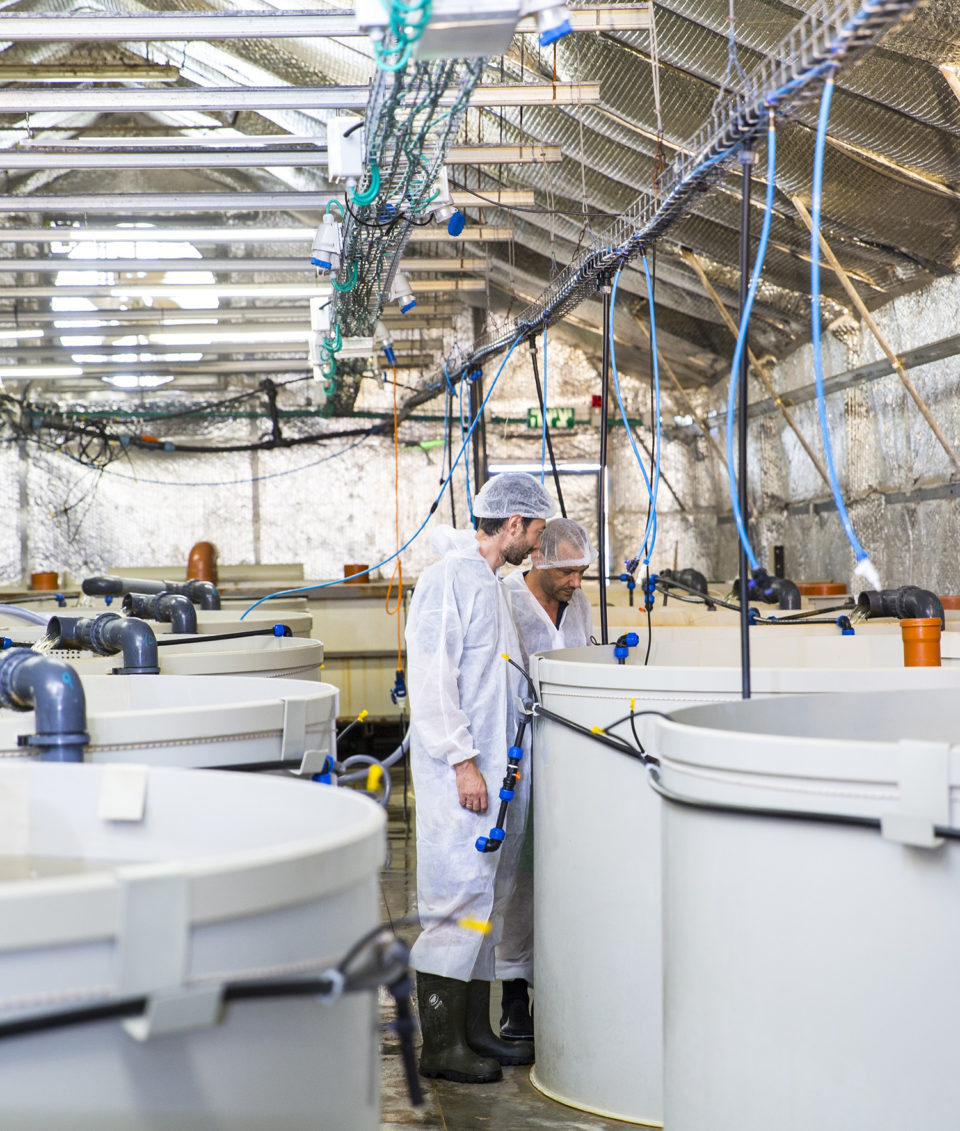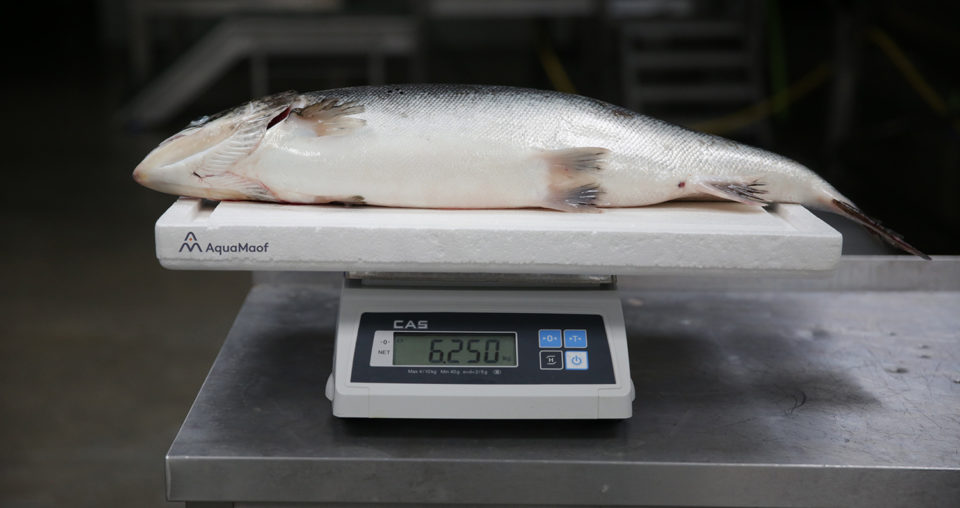Global demand arises for Israel-based company’s RAS expertise

Three decades ago, a pair of brothers ventured into aquaculture on a kibbutz in the Beit She’an Valley. Yoav Dagan and Nitay Goldman produced carp and tilapia using traditional methods, but soon found conditions for fish farming in Israel less than ideal. The country does not have much water, or even much land, and temperatures are high.
But constraints lead to innovation, and the brothers turned to technology to overcome the cards nature had dealt them. When the aquaculture systems they bought could not meet their needs, they researched and developed their own. Their fish pond technologies proved so effective at increasing efficiency and reducing mortality that over the years they have been used in more than 50 projects producing 16 different species across the globe.
In 2010, four co-founders then joined forces with Dagan to specialize in recirculating aquaculture systems (RAS). They set up AquaMaof, which has become a world leader in this technology.
“In Israel, it’s very, very hard to be a fisherman,” said Shai Silbermann, the company’s VP of marketing and sales. What he calls a “new generation of fish farmers” is combining traditional methods and human ingenuity to push the boundaries of what was previously possible.
“The DNA of the company is fish production,” said Silbermann. He added that cultivating fish using indoor, land-based containment systems not only takes pressure off the oceans and other natural resources, but also provides farmers with more control over their harvests and gives consumers peace of mind.
Global rollout of RAS facilities
AquaMaof’s technology has been rolled out to 10 facilities around the world, in places like Japan, Russia, Slovakia, Germany, France, Norway, Canada, the United States and Chile, with more still in the pipeline. Some sites are already operational, while others are under design or construction. There are also two R&D centers – one in Poland, which is also being used as proof-of-concept and for training staff, and the other in Israel.
Many of the company’s competitors moved into the RAS sector from the water treatment industry, but AquaMaof’s approach is somewhat different.
“The philosophy here is that we’re using physical elements instead of mechanical elements,” said Silbermann. The system does not for example use drum filters and the discharge rate is at 1 percent, compared to competitors’ average of 10 percent. “We’re using the same volume of water, but we discharge much less,” he said.
Silbermann explained that taking in, discharging, treating and controlling the temperature of water requires a significant amount of power. The company’s technology consumes about one-third of the energy used by other RAS-installations, meaning operational costs are much lower.

Cultivating a wide range of species
“We can basically do whatever species we want,” said Silbermann, adding that AquaMaof’s system has been used to produce salmon, sturgeon, trout, grouper, tilapia, sea bream and catfish, among others. In October, the company also announced plans for indoor land-based shrimp production. The R&D took three years and the technology will be released onto the market next year.
The most popular species being produced is, however, Atlantic salmon, along with other species like coho. “They receive a premium price and it’s a very developed industry,” he said.
The eggs are a commodity and according to Silbermann customers can choose from numerous producers or distributors operating in a nearly endless market.
“The bottlenecks in the industry usually come from the eggs or the fingerlings – the broodstock that you have or don’t have,” he said. “It’s not the technology, it’s the biology.”

A flexible, scalable aquaculture system
The technology is also flexible. Facilities can be designed for one species, but later changed to another. For example, the company’s Global Fish operation in Poland initially produced 1,200 tons of tilapia, but then switched over to salmon when prices bottomed out because of imports from China.
“Going from a warm species in freshwater into a cold species using salinity is harder than to do the opposite, and we succeeded,” said Silbermann.
The system is also scalable and optimum production yields depend on a number of factors.
“To start small is 2,500 tons (annually) of salmon,” he said. “For other species, it depends on the price you get on the market.”
Species like tilapia are on the low end of the price spectrum. “You can get it for $2 to $3, so to go beneath 10,000 tons with those kinds of prices is kind of suicide,” he said.
For other species, like grouper, prices are much higher. “You can reach up to $30 per kg in some places, so you can do 1,000 tons,” he said.
The weight of the fish also needs to be considered. Silbermann explained that trout can be sold at between 700 grams and 1 kg, taking about three-quarters of a year to reach market-size. Salmon, however, needs to reach between 4 to 5 kg and should remain at the site for about two years.
“You need to invest more to maintain your fish, and probably the risks are higher, because as long as they stay in your facility, you can also have mortality,” he said.

RAS technology in an emerging market
The RAS industry is still developing and Silbermann stressed the importance of analyzing the market and choosing the right species of fish.
“You need to verify you will have good returns,” he said. “If you choose the wrong fish – for example if you want to go for 1,000 tons of tilapia in the middle of Europe – these days your plan will be a failure.”
He added that investors should also select locations with good infrastructure, with stable electricity grids and water supply, and ensure contingency plans are in place. Strict biosecurity protocols are also crucial in super-intensive aquaculture and operations need a strong management team.
“You need to be consistent in what you are doing every day,” he said. “You cannot cut corners with this, especially with fish, but livestock as a whole.”
The facilities are mostly automatic, requiring far less labor, although staff need to be highly skilled and often come from engineering backgrounds. Silbermann said 15 to 20 employees could run facilities of about 1,000 tons, while traditional operations might need 50. More staff would however be needed for installations with processing plants.
A unique business model
AquaMaof’s technology has been chosen by major players like 8F Asset Management and Grieg NL. The company sells its proprietary equipment, but also often partners with its investors.
“This is a strategic decision that we took,” said Silbermann. “We still think and believe that to make the real money, it’s in the production.”
For investors, this presents a clear advantage, too. “We’re also part of the risk,” he said. “We’re showing the customer our confidence in the industry and especially the technology.”
AquaMaof is aiming for a total annual production yield of 450,000 tons across all its sites and Silbermann is optimistic about the sector’s growth. “We believed in the RAS system from the beginning and understood that this was the future of the industry,” he said. “The future is huge, and the trail has just started.”
Follow the Advocate on Twitter @GAA_Advocate
Now that you've finished reading the article ...
… we hope you’ll consider supporting our mission to document the evolution of the global aquaculture industry and share our vast network of contributors’ expansive knowledge every week.
By becoming a Global Seafood Alliance member, you’re ensuring that all of the pre-competitive work we do through member benefits, resources and events can continue. Individual membership costs just $50 a year. GSA individual and corporate members receive complimentary access to a series of GOAL virtual events beginning in April. Join now.
Not a GSA member? Join us.
Author
-

Marie-Louise Antoni
Marie-Louise Antoni is a freelance journalist based just outside of Cape Town, South Africa. She writes on crime, politics, law and the environment.
Tagged With
Related Posts

Innovation & Investment
At seafood investor forum, a ‘blue-sky’ outlook and a search for the next salmon
At the IntraFish Seafood Investor Forum in New York, “all roads lead to salmon.” Buoyed by high prices and soaring demand, the sector is an example worth following. But it’s not without its challenges.

Innovation & Investment
Africa’s first land-based salmon farm a landmark for Lesotho
A Singapore-based company aims to make Lesotho, a nation of 2 million people, known for a local fish that’s truly anything but local: Atlantic salmon.

Innovation & Investment
Is RAS the game-changer that Europe’s aquaculture sector needs?
The impact that recirculating aquaculture systems, or RAS, will have on European production remains to be seen, but the general vibe is positive.

Intelligence
RAS in the USA: Fad or future?
A rash of large-scale, land-based recirculating aquaculture systems (RAS) are planting their flags on U.S. soil, even though it will take several years and hundreds of millions of dollars of investment before they produce their first sellable fish.

